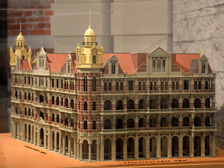
Mail memories:
The grand old General Post Office building was completed in 1911, and stood at the junction of Pedder Street and Des Voeux Road where World-Wide House is now situated.
Mail memories:
The grand old General Post Office building was completed in 1911, and stood at the junction of Pedder Street and Des Voeux Road where World-Wide House is now situated.
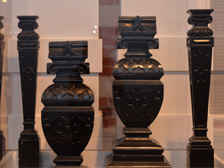
Interior design:
A few of the intricately carved balusters and newels from the wooden staircase were preserved when the old GPO building was demolished in 1976.
Interior design:
A few of the intricately carved balusters and newels from the wooden staircase were preserved when the old GPO building was demolished in 1976.
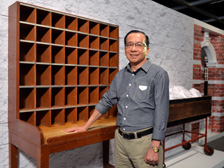
Stand-up staffer:
Wong King-man began working at the GPO as a mail sorter in 1964, and spent 38 years in Hongkong Post’s employ.
Stand-up staffer:
Wong King-man began working at the GPO as a mail sorter in 1964, and spent 38 years in Hongkong Post’s employ.
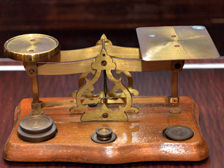
Mail memento:
This scale was used at the old GPO to weigh items to be posted.
Mail memento:
This scale was used at the old GPO to weigh items to be posted.
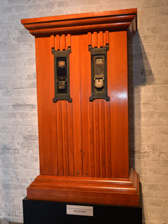
Early automation:
The mechanical stamp vending machine introduced in the 1950s provided convenience and reduced the long lines at the stamp counters.
Early automation:
The mechanical stamp vending machine introduced in the 1950s provided convenience and reduced the long lines at the stamp counters.
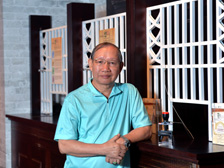
Called to account:
So Lam worked at the stamp counter in the old GPO, and was careful not to let stamps stick together and to double-check his math as clerks had to cover any losses.
Called to account:
So Lam worked at the stamp counter in the old GPO, and was careful not to let stamps stick together and to double-check his math as clerks had to cover any losses.
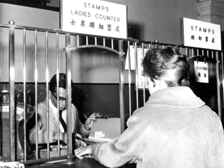
Feminine favour:
In the 1950s, the old GPO opened a ladies-only counter so they could avoid the long queues. (Photo courtesy of Hongkong Post)
Feminine favour:
In the 1950s, the old GPO opened a ladies-only counter so they could avoid the long queues. (Photo courtesy of Hongkong Post)
Postal staff recount GPO tales
June 08, 2014
A Hongkong Post exhibition showcasing the old General Post Office that stood at the Junction of Pedder Street and Des Voeux Road from 1911 to 1976 comes alive through interviews with people who worked there.
Though the grand old GPO building was demolished four decades ago to make way for World-wide House, it looms large in the memory of its former staff.
Mail items posted on Hong Kong Island were all sent to the GPO, where they were poured onto facing tables. Postal staff manually segregated the letters with the address side facing up, to make it easier to sort the mail and cancel the stamps.
Stand-up sorting
Wong King-man was assigned to the mail-sorting department when he joined the GPO in 1964 and recalls the physical demands of the job.
“The sorting table had 48 cells. We had to stand when we sorted the letters because it was faster and we were better able to reach. We worked seven hours a day and sorted 1,500 letters an hour. I was extremely tired at the end of the workday.”
Mr Wong said there were about 20 workers responsible for sorting letters, but only four chairs for them to share.
“Staff would return to the office as early as possible to get a chair. Once the four lucky guys claimed them, they wouldn’t stand up - not even to use the toilet. To get someone out of the chair, they would pretend he had a call on the phone in the canteen. When he went to take the call, another guy took his chair.”
Mr Wong, now 68 years old, worked at the GPO for 38 years, working his way up from a temporary clerk to Controller of Posts.
Held to account
The old GPO building was completed in 1911. To meet the great demand for postal services in the post-war period, an increasing number of stamp counters were set up in its ground floor lobby.
After spending more than a month as a mail sorter when he joined the GPO in 1958, So Lam was asked to work at the stamp counters.
“We did not have much experience at that time and office boys made us anxious. They came in with a piece of paper stating how many stamps the boss needed. For example, five 10-cent stamps, three 25-cent stamps. It was good that I knew how to use the abacus. Many colleagues who did not know how to use it did the math manually and made many mistakes.”
Mr So said they worked hard to earn their $270 monthly salary, and had to cover any losses if they miscalculated.
“A clerk once lost seven dollars at the end of the day. He lost another five dollars the next day. On the third day, he asked for another job.”
At that time, postage stamps were known as “sze-tam”, a transliteration of the word “stamp”. The stamp paper was thin and stamps easily stuck together. Mr So said they paid extra attention when they sold high-value stamps, tearing them apart carefully. If they unknowingly gave double to the customers, they had to cover the loss.
“One of my colleagues once sold a $10 stamp and was quite nervous. He rubbed the stamp again and again to make sure he was giving the customer only one. When he finally handed it over, the glue was all gone.”
Feminine side
In the 1950s, the GPO set up a special ladies-only counter, primarily to serve the expatriate women who Mr So recalls were usually well dressed.
“Most of the women customers lived on the Peak and travelled on the Peak Tram. Tram service was sparse and they needed to wait a long time if they had just missed it. When they arrived at the GPO and saw so many people queuing in the lobby with no air-conditioning, they asked if it was possible to open an exclusive counter for their use,” he explained.
The old GPO was always busy with thousands of people going in and out each day to send their mail and parcels.
“There were usually long queues of people who were not in a good mood after standing in line. The clerks’ workload was heavy, which may have made them impatient when serving customers. We invited an actor to participate in a video to teach staff to be polite to customers,” Mr Wong said.
The actor played two roles, acting as twin brothers – one a post-office worker, the other a camera salesman. After the post-office worker was impolite to a customer, his twin went to the customer’s restaurant. In a case of mistaken identity, the customer – who managed the restaurant – refused to serve him. The twin relayed the incident to his brother, and asked him to change his ways.
The video is part of the Hongkong Post exhibition titled “A Journey through Hong Kong’s Postal History – A Glimpse of Hong Kong’s Postal History through the Old General Post Office Building (1911–1976)” at the Hong Kong Heritage Discovery Centre in Kowloon Park.
The exhibition features photos, postal tools, stamps issued during the period and a collection of models based on the building. Visitors can also enjoy an oral history, presented in recorded interviews of former staff.
For details, visit Hongkong Post’s website.